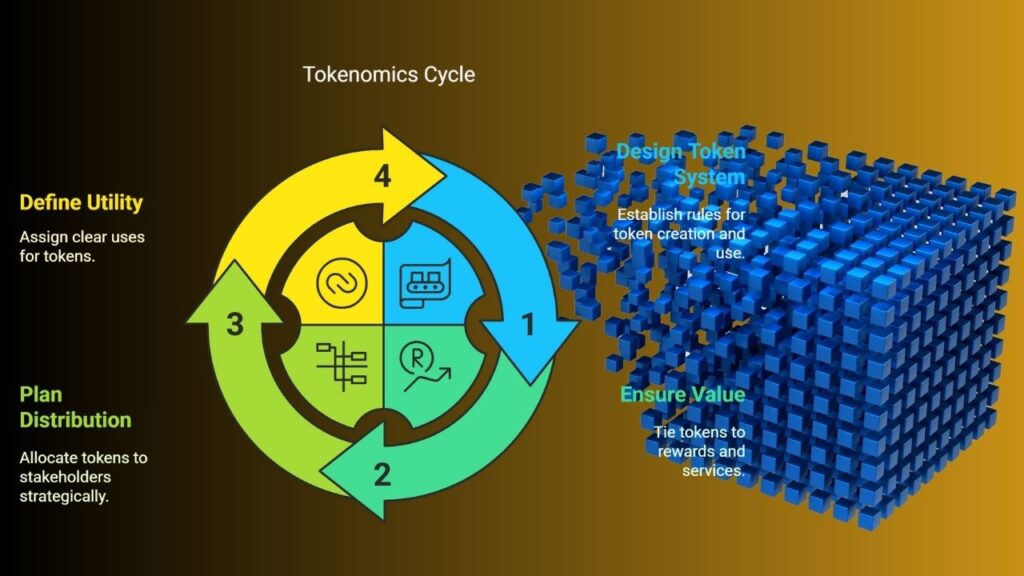Starting a Web3 startup can feel confusing, right? The Web3 space is booming, with blockchains and crypto assets creating new opportunities daily. This guide breaks down the process into 10 simple steps to help you succeed.
Ready to get started?
Define Your Vision and Mission
Think big but stay clear. Your vision should show the future you want to create with your Web3 startup. Write it down in one sentence that inspires trust and excitement.
Your mission explains how you’ll achieve this vision. Focus on solving specific problems for your target audience. For example, using smart contracts or stablecoins can streamline processes while adding value to users’ lives.
A strong mission fuels action, while a bold vision shapes the journey.
Conduct Market Research
Study what people need and want in Web3. Spot problems others haven’t solved yet.
Identify gaps in the Web3 space
Spotting gaps in Web3 needs sharp eyes. Many startups focus on NFTs, crypto wallets, or token sales. Yet areas like real-world asset tokenization and cross-chain compatibility often lack solutions.
Users still struggle with poor user experience in dApps and high gas fees.
Some sectors need smarter moves. For example, better tools for yield farming could simplify liquidity mining processes. Email address-based onboarding might help non-crypto users embrace this space faster too! Talking directly to early adopters can reveal even more pain points hidden beneath the surface.
Analyze competitors and existing solutions
Sure! Here’s the response you requested in HTML Table format:
To make smart decisions, you need to study your competitors and what’s already out there. This research will help you avoid reinventing the wheel while sharpening your offering.
| Steps | Action | Purpose |
|---|---|---|
| 1. Identify Competitors | List similar Web3 projects in your space. | Know who you’re up against. |
| 2. Study Their Features | Break down their apps, tools, or platforms. | Find what works and where they stumble. |
| 3. Check User Feedback | Read reviews or join discussions on platforms like Reddit or Discord. | Learn about gaps or user frustrations. |
| 4. Analyze Their Tokenomics | Explore their token models, supply, and utility. | Spot weak points or inefficiencies. |
| 5. Assess Their Community | Evaluate activity on platforms like Telegram or Twitter. | Gauge their audience engagement levels. |
| 6. Benchmark Market Position | Compare their performance and market presence. | Set realistic goals for your startup. |
| 7. Evaluate Innovation | Pinpoint areas where they’ve broken new ground. | Inspire fresh ideas without copying. |
| 8. Note Pricing Models | Understand how they structure fees or token sales. | Develop competitive pricing strategies. |
If you skip this step, you’re flying blind. Study smart and plan better.
Choose the Right Blockchain and Technology Stack
Pick a blockchain that fits your goals, whether it’s Ethereum for flexible apps or another platform. Use tools like Flutter or Dart to speed up development and keep things simple.
Evaluate blockchain platforms
Choosing the right blockchain platform is key for your Web3 startup. It impacts cost, scalability, and user experience.
- Compare transaction speeds. Some platforms handle thousands per second, while others may lag behind. Faster ones are better for high traffic.
- Review fees per transaction. Ethereum is popular but often expensive. Look for lower-cost options if your budget is tight.
- Check security history. A platform with frequent hacks can hurt your trust factor.
- See scalability options. Make sure it will support more users as you grow.
- Look for developer tools compatibility like Flutter or Dart to speed up creation.
- Research community support and forums to find help when needed.
- Study past performance of token launches on the platform to predict success probabilities.
- Analyze energy use—Ethereum Foundation moved to proof-of-stake for this reason—and pick greener choices if that matters in your plan.
- Test interoperability so tokens or assets flow well between chains if required by your model.
- Understand legal implications tied to certain blockchains in target regions regarding securities laws or regulatory compliance issues
Select development tools and frameworks
Picking the right tools and frameworks is key for your Web3 startup. It saves time and keeps things smooth.
- Research blockchain development kits like Truffle or Hardhat. They help with coding, testing, and deployment.
- Use Solidity if building on Ethereum-based platforms. It’s the main language for smart contracts there.
- Explore Rust for blockchains like Solana or Polkadot. It’s fast and safe for coding complex apps.
- Choose a wallet integration tool such as WalletConnect or MetaMask SDK for user-friendly access to dApps (decentralized apps).
- Leverage IPFS (InterPlanetary File System) for decentralized file storage if data management is critical in your app.
- Opt for a reliable API provider like Alchemy or Infura to connect your app with blockchain networks effortlessly.
- Test using Ganache, which offers a local Ethereum chain emulator for debugging errors before going live.
- Try frameworks like React.js with Web3.js libraries to make your front-end interactive while linking it to blockchain features.
- Select Chainlink if inputting verified real-world data into smart contracts is part of your project scope.
- Use monitoring tools such as Etherscan APIs to track transactions, ensuring smooth functionality post-deployment.
Develop a Strong Value Proposition
Stand out by showing what your Web3 startup offers that others can’t. Focus on solving real problems or filling gaps in the market. Highlight specific benefits for users, like faster transactions, lower fees, or improved security.
Use clear and simple language to explain why your project matters. Aim to create trust with transparency about how it works. Show how your solution provides long-term viability in a crowded space.
A strong value proposition can set you apart and attract both users and investors.
Build a Community
Start conversations, make connections, and let people share your vision—because a great Web3 startup thrives on its supporters.
Leverage social media and forums
Use Twitter, Reddit, and Discord to grow your Web3 startup. Post updates, share ideas, and interact daily. Reply to questions fast to build trust. Look for forums where Web3 enthusiasts gather, like Bitcointalk or GitHub discussions.
Host AMAs (Ask Me Anything) on social platforms. Ask for feedback on your minimum viable product from these groups. Encourage retweets of key announcements to spread awareness quickly.
Stay active and show you’re listening—this builds a loyal community over time!
Engage early adopters and enthusiasts
Find people who love Web3 and share your ideas with them. Share project updates on social media or forums where tech fans hang out, like Discord or Reddit. These people are often eager to test new solutions and give honest feedback.
Offer perks like early access, thanks tokens, or exclusive features. This builds trust and shows appreciation for their support. Active community members can become your biggest promoters, helping spread the word faster than any ad campaign could.
Create a Whitepaper
Draft a clear and strong whitepaper. This document explains your Web3 startup idea in detail. Include the problem, your solution, market potential, and tokenomics. Use simple words to connect with readers who might not be experts.
Make it professional yet easy to understand. Add charts or graphs if needed but keep them simple too. A good whitepaper can help you gain trust from venture capital investors or early supporters of your project.
Design and Develop Your MVP (Minimum Viable Product)
Start small, but smart. Focus on creating a product that solves one key problem effectively.
Outline key features
List the main functions your MVP must have. Focus on what solves your users’ biggest problems. Skip flashy extras at this stage; simplicity works best. A Web3 startup might need a secure wallet, token system, or smart contracts.
Test features to see what works well and toss what doesn’t. Each part should serve a clear purpose. For example, if building a marketplace, prioritize payment options and user profiles first.
Keep key features lean for fast feedback from early adopters.
Prioritize functionality
Focus on making your MVP work smoothly. Users care more about a product that works than one with flashy features. Skip unnecessary extras and ensure key functions deliver value.
Test the core tools early. Fix bugs fast, so users stick around. A functional app builds trust, especially in Web3 startups where competition is tough. Simple and effective beats complex every time.
Focus on Tokenomics
Think about how tokens will work in your business. Plan their use, value, and flow carefully to gain trust and long-term support.
Design a sustainable token economy
Build clear rules for your token system. Decide how tokens will be created, shared, and used. Make sure the supply matches demand to avoid inflation or scarcity.
Give your tokens real value. Tie them to rewards, services, or special access in your project. This keeps people interested and encourages long-term use.
Plan token distribution and utility
Decide who gets your tokens and why. Split them wisely between team members, investors, and the community. Reserve some for future growth or partnerships too.
Give tokens clear uses. Let users trade, vote, or access special features with them. This keeps people involved while boosting your token’s value over time.
Secure Funding
Pitch your idea to investors with bold confidence. Explore grants, token sales, or partnerships to fuel your growth.
Explore venture capital and grants
Venture capital can give your Web3 startup the boost it needs. Investors look for projects with a strong value proposition and growth potential. Show them how your startup stands out and solves real problems in the market.
Grants are another great way to get funds, especially from blockchain foundations like Ethereum or Polkadot. These often support innovative ideas that push tech limits. Research grant options early to avoid missing deadlines.
Consider token sales and crowdfunding
Token sales can fund your startup fast. Crowdfunding reaches many small investors who share your goals. Platforms like Kickstarter or Indiegogo make this easier. Initial coin offerings (ICOs) are another route, letting people buy tokens early to support and use your product.
Set clear goals before starting. Decide how much money you need and explain your token’s utility well in a whitepaper. Offer rewards or perks to attract backers. Be transparent with budgets, timelines, and updates—trust is key for success here!
Ensure Legal Compliance
Legal rules can be tricky, but skipping them can cost you big time. Get clear on what’s required in your target regions to dodge future headaches.
Research regulations in your target markets
Study the laws in each market. Focus on rules for blockchain, tokens, and data use. Some countries treat cryptocurrencies as property; others see them as currency. Learn how taxes work where you plan to operate.
Check if your Web3 startup needs licenses or permits. Look at privacy laws like GDPR in Europe or CCPA in California. Ignoring these can lead to big fines or shutdowns.
Prepare necessary legal documents
Draft contracts for token sales and partnerships. Include terms that protect your startup and investors. Create privacy policies to explain how user data will get handled.
Follow regulations in your target market. File incorporation papers, licensing documents, and tax forms early. A small mistake here can cost big later, so double-check everything!
Launch a Marketing Campaign
Spread the word with bold and clear messaging. Use creative strategies to grab attention and spark interest in your startup.
Utilize Web3-specific marketing strategies
Target crypto-friendly platforms like Twitter, Discord, and Telegram. These channels are hotspots for Web3 communities. Create educational content that explains your project in simple terms.
Share updates, hold AMAs (Ask Me Anything), and interact with questions to build trust.
Offer NFTs or tokens as rewards for engagement. Gamify promotions with tasks like creating memes or sharing posts. Partner with influencers who understand blockchain tech to expand visibility without breaking the bank.
Build partnerships to boost visibility
Partner with projects, influencers, or platforms in the Web3 space. Collaborate to share audiences and expand your reach. Choose groups that align with your startup’s goals. Partnerships can amplify your message faster than working alone.
Host joint events like AMAs (Ask Me Anything) on forums or create co-branded content. This builds trust among shared communities. Focus on long-term collaborations for steady growth and visibility.
Test and Optimize Before Launch
Check your product for bugs or glitches. Run it through different scenarios to see how it performs. Users expect smooth experiences, so focus on fixing weak spots early. Test your Web3 startup with real users if possible.
Collect feedback from testers and refine the features. Fine-tune tokenomics, security measures, and community tools based on findings. Small tweaks can give you a competitive advantage before the big launch day arrives!
Launch Your Web3 Startup
Hit the ground running with your Web3 startup. Set a firm launch date and stick to it. Publicize the big day across social media, forums, and blockchain communities. Offer sneak peeks or countdowns to build excitement among early adopters.
On launch day, deploy your product smoothly. Spread updates through email lists, announcements on platforms like Discord or Telegram, and strategic partnerships. Monitor feedback closely from users in real-time.
Adjust quickly to any hiccups for a strong start that builds trust with your community.
Takeaways
Starting a Web3 startup may feel like building a plane while flying it. But with clear steps, focus, and the right tools, you can make it work. Stick to your goals, listen to your users, and adjust as needed.
The future of tech thrives on bold ideas—yours could be next!
FAQs
1. What is a Web3 startup?
A Web3 startup is a business built on blockchain technology, focusing on decentralization and user ownership. It often involves innovative ideas to reshape online interactions.
2. Why is regulatory compliance important for Web3 startups?
Regulatory compliance helps your startup avoid legal trouble and build trust with users and investors. Laws vary by region, so research rules in places like co.uk or com.au carefully.
3. How can I attract venture capital for my Web3 project?
To gain venture capital, create a clear plan showing long-term viability. Share how you’ll grow the business, build community support, and solve real problems.
4. Why does community building matter for start-ups in the Web3 space?
Community building creates loyal supporters who spread the word about your project. A strong community also boosts credibility and keeps people engaged over time.










































